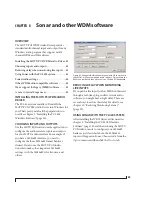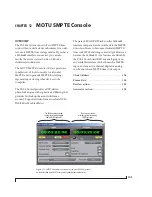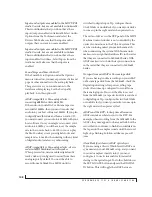
R E D U C I N G M O N I T O R I N G L A T E N C Y
93
Figure 10-3: Lowering the ‘Samples Per Buffer’ setting in the MOTU
PCI Audio Console Window reduces patch thru latency. But doing so
increases the processing load on your computer, so keep an eye on
the Performance Monitor window in your host audio software.
For details on how to access the MOTU PCI Audio
Console window show above in Figure 10-3, see
“Accessing the PCI Audio Console window” on
page 63.
The Samples Per Buffer setting has a large impact
on the following things:
■
Patch thru latency
■
The load on your computer’s CPU
■
Possible distortion at the smallest settings
■
How responsive the transport controls are in
AudioDesk, Digital Performer or other audio
software
Lower latency versus higher CPU overhead
The
Samples Per Buffer
setting presents you with a
trade-off between the processing power of your
computer and the delay of live audio as it is being
patched through your software. If you reduce the
Samples Per Buffer, you reduce patch thru latency,
but significantly increase the overall processing
load on your computer, leaving less CPU
bandwidth for things like real-time effects
processing. On the other hand, if you increase the
Samples Per Buffer, you reduce the load on your
computer, freeing up bandwidth for effects, mixing
and other real-time operations.
If you are at a point in your recording project where
you are not currently working with live, patched-
thru material (e.g. you’re not recording vocals), or
if you have a way of externally processing inputs,
2. CueMix™ DSP immediately patches the
live mic signal directly to the main outs (or
other output), completely bypassing the
computer (dry, with no effects processing).
3. Mic signal is mixed with the main
outs, and you can control the volume
(relative to the rest of the mix) with the
mic’s fader in CueMix Console.
Figure 10-2: This diagram shows the signal flow when using CueMix™ DSP no-latency monitoring. Notice that this method does not allow you
to process the live input with plug-ins in your audio software while it is being monitored. You can, however, add effects later — after recording
the live input as a disk track. CueMix™ DSP lets you hear what you are recording with no delay and no computer-based effects.
1. Live input (from mic, guitar, etc.)
enters the MOTU interface.
Summary of Contents for PCI-424
Page 35: ...6 ...
Page 43: ...14 ...
Page 45: ...16 ...
Page 53: ...P A C K I N G L I S T A N D P C S Y S T E M R E Q U I R E M E N T S 24 ...
Page 83: ...I N S T A L L I N G T H E P C I 4 2 4 H A R D W A R E 54 ...
Page 103: ...M O T U P C I A U D I O C O N S O L E 74 ...
Page 111: ...C U B A S E N U E N D O A N D O T H E R A S I O S O F T W A R E 82 ...
Page 115: ...S O N A R A N D O T H E R W D M S O F T W A R E 86 ...
Page 119: ...E X P A N D I N G Y O U R P C I 4 2 4 S Y S T E M 90 ...
Page 125: ...R E D U C I N G M O N I T O R I N G L A T E N C Y 96 ...
Page 131: ...C U E M I X C O N S O L E 102 ...
Page 148: ...6 ...
Page 156: ...14 ...
Page 158: ...16 ...
Page 166: ...P A C K I N G L I S T A N D M A C I N T O S H S Y S T E M R E Q U I R E M E N T S 24 ...
Page 194: ...I N S T A L L I N G T H E P C I 4 2 4 H A R D W A R E 52 ...
Page 230: ...A U D I O D E S K 88 ...
Page 246: ...E X P A N D I N G Y O U R P C I 4 2 4 S Y S T E M 104 ...
Page 258: ...C U E M I X C O N S O L E 116 ...
















































